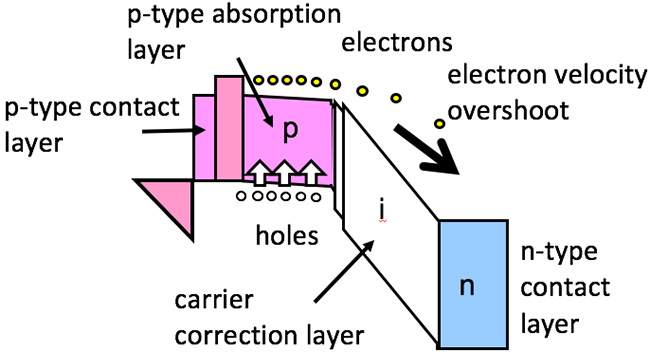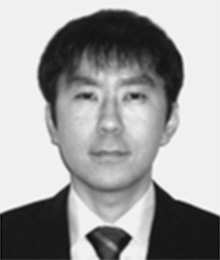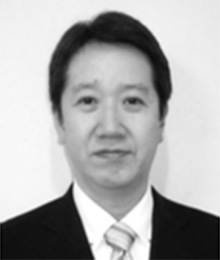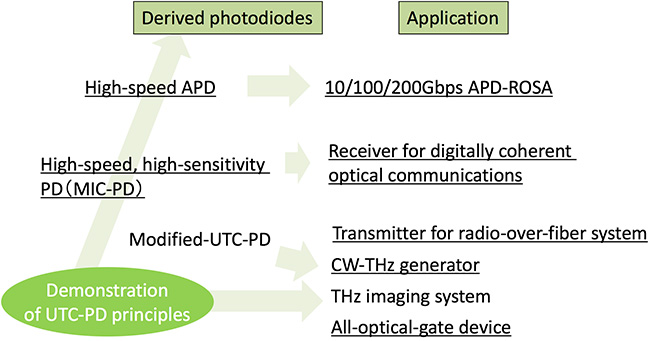Todayfs widespread use of the internet is sustained by continuous progress in optical fiber communications technologies aimed at providing high-capacity optical transmission systems. The capacity of optical communications systems has increased owing to not only higher band rates, but also to the development of various multiplexing technologies such as a wavelength division multiplexing. One of the key devices for optical communications is the photodiode (PD), which converts an optical signal after fiber transmission into an electrical signal. Recently developed transmission systems have required PDs with higher speeds, output power, and sensitivity.
In a PD, the optical signal is received by the light-absorption layer, and electrons and holes are generated and move to the cathode and anode electrode, respectively. Conventionally, the lower drift speed of holes compared with that of electrons had been a factor limiting the speed and output power of PDs. In 1997, one of the award winners and his colleagues conceived of the idea of using p-type indium gallium arsenide (InGaAs) as a light-absorption layer to eliminate slow hole drift, which enables a dramatic increase in the speed and power of opto-electric conversion. Then they demonstrated this concept as a uni-traveling-carrier photodiode (UTC-PD). Subsequently, they succeeded in demonstrating PDs with ultrahigh speeds exceeding 300 GHz. Furthermore, by utilizing the high output characteristics of the UTC-PD, they applied an optical gate to directly drive the optical modulator at the UTC-PD output.
In addition, based on this UTC-PD technology, the winners also developed the maximized induced current photodiode (MIC-PD), whose light-absorption layer combining p-doped InGaAs and non-doped InGaAs makes high-speed and high-sensitivity characteristics compatible. The MIC-PD and its design concept were applied to receivers for optical communications networks, such as the160-Gbit/s ASK system, 40-Gbit/s DQPSK system, and 100-Gbit/s digital coherent system. They were also applied to high-speed avalanche photodiodes for metro networks and Ethernets. This receiver technology supports one end of the optical communications network.
While working to deploy optical communications systems, the winners found that terahertz (THz) waves can be generated as UTC-PD output through the opto-electric conversion of a beat light signal comprising two superimposed lights of different frequencies. This work resulted in the development of a terahertz (THz) continuous-wave photonic generator. The photonic generator was also applied to transmitters of radio-over-fiber systems that superimpose radio signals on light. It has also contributed to advances in THz-wave imaging and measuring instruments. As a result, numerous research institutes are pursuing developments based on the UTC-PD and technologies derived from it. The contributions of the winners to the academic field are remarkable.
As described above, the award winners have proposed and realized ultrahigh-speed, high-output-power, and high-sensitivity PDs and have contributed greatly to the advancement of receiver techniques for optical transmission systems. In addition, they have taken a leadership role in the field of THz wave generation and its applications. Their achievements are highly noteworthy and deserving of the IEICE Achievement Award.
References
- T. Ishibashi, N. Shimizu, S. Kodama, H. Ito, T. Nagatsuma, and T. Furuta, "Uni-Traveling Carrier Photodiodes," Tech. Dig., Ultrafast Electronics and Optoelectronics, (1997 OSA Spring Topical Meeting), pp.166-168, 1997.
- H. Ito, T. Furuta, S. Kodama, T. Ishibashi, , gInP/lnGaAs uni-travelling-carrier photodiode with 310 GHz bandwidth,h Electron. Lett., Vol. 36, No.21, pp.1809-1810, 2000.
- S. Kodama, T. Yoshimatsu, T. Ito, H. Ito, and T. Ishibashi , g160 Gbit/s error-free demultiplexing by ultrafast optical gate monolithically integrating photodiode and electroabsorption modulator,h Electron. Lett., Vol. 38, No. 24. pp.1575-1576, 2002.
- Y. Muramoto, and T. Ishibashi, gInP/InGaAs pin Photodiode Structure Maximizing Bandwidth and Efficiency,h Electron. Lett., 39, No. 24. pp.1749-1750, 2003.
- Y. Muramoto, K. Yoshino, S. Kodama, Y. Hirota, H. Ito, T. Ishibashi, g100 and 160 Gbit/s operation of uni-travelling-carrier photodiode module,h Electron. Lett., pp.378-380, 2004.
- T. Yoshimatsu, Y. Muramoto, S. Kodama, T. Furuta, N. Shigekawa, H. Yokoyama, and T. Ishibashi, gSuppression of space charge effect in MIC-PD using composite field structure,h Electron. Lett., Vol. 46, No. 13. pp.941-943, 2010.
- H. Ito, T. Furuta, F. Nakajima, K. Yoshino, and T. Ishibashi, gPhotonic generation of continuous THz wave using uni-traveling-carrier photodiode,h J. Light. Technol.,Vol. 23, pp.4016-4021, 2005.
- T. Ohno, S. Fukushima, Y. Doi, Y. Muramoto, and Y. Matsuoka , gTransmission of millimeter-wave signals in a fiber-radio system using a unitraveling-carrier waveguide photodiode,h Photonics Technol. Lett., Vol.12, pp.1379-1381, 2000.
- Y. Hirota, Y. Muramoto, T. Takeshita, T. Ito, H. Ito, S. Ando, and T. Ishibashi,gReliable non-Zn-diffused InP/InGaAs avalanche photodiode with buried n-InP layer operated by electron injection mode,h Electron. Lett., 40, No. 21. pp.1378-1379, 2004.
- M. Nada, Y. Muramoto, H. Yokoyama, N. Shigekawa, T. Ishibashi and S. KodamagInverted InAlAs/InGaAs Avalanche Photodiode with Low-High-Low Electric Field Profile,h Jpn. J. Appl. Phys. p. 02BG03, 2012.

Fig. 1 Structure of UTC-PD.
Fig. 2 Development of research fields related to the UTC-PD.







